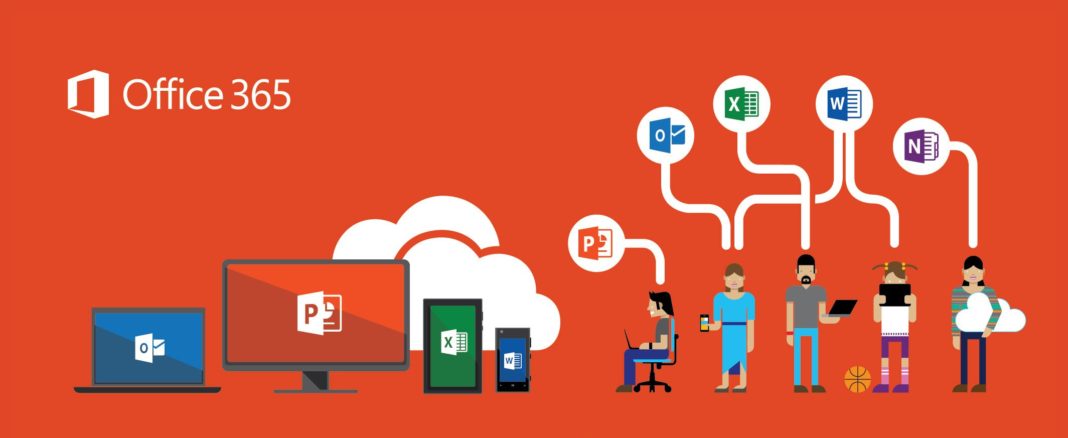From May 21st to 23rd, Microsoft has once again hosted SharePoint Conference, one of its biggest tech events, with many new announcements and revealing a lot of exciting new features in the Microsoft world, including SharePoint and Office 365.
Introduction
SharePoint and Office 365 have come a long way and it is nothing but amazing to see the constant innovation that Microsoft has been introducing to the platform over the years!
There are lot of new announcements being released at a very fast pace and it is challenging to stay up to date with everything that is being released!
This post will try to resume the latest announcements in the SharePoint and Office 365 world and what it means for end users, IT Pros and developers.
Hope you are ready for a ride, fasten your seat belt, because there are many new features coming (some of them may be already rolled out at the time of this writing). While it is impossible to talk about everything that has been announced, I will try to resume some of the biggest announcements in a two part series. These are the main topics I will discuss in the second part of this two part series:
- What’s New for Administrators
- What’s New for Security and Compliance
- What’s New for SharePoint Server (On-Premises)
- Fluid Framework
- Other Relevant Announcement
To read the first part of this post series, click here.
What’s New for Administrators
As in other areas, there are a lot of new announcements for administrators.
SharePoint Admin Center
In Preview for some time, the modern SharePoint admin center will become the default experience for administering SharePoint Online including the management of classic experiences through the new modern UI. Below, some of the most important announcements.
Consolidated Views (Available Soon)
With the new update, in the new SharePoint admin center experience you can manage both settings related to modern SharePoint experiences and classic features, meaning that there will be no need to to work across modern and classic admin centers to manage settings across modern and classic settings.


Bulk Actions (Available Soon)
Soon it will be possible to performing bulk actions against a collection of sites. These actions include updating the site’s sharing configuration, performing hub site association or deleting sites.
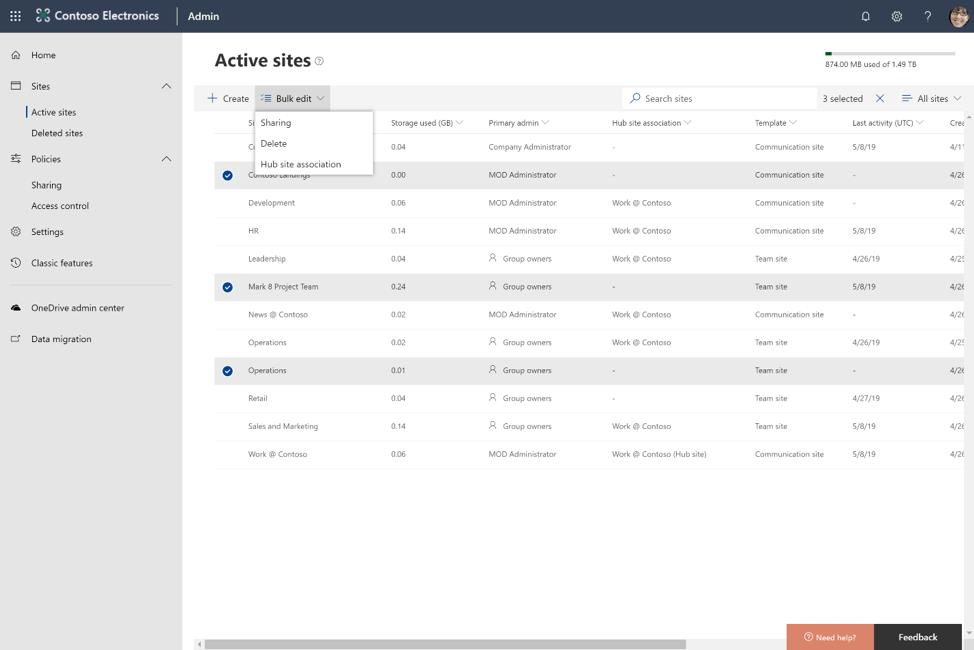

Site URL Rename (Available Soon)
One my favorite announcements of the whole event! Site URL Rename has been one of the most popular requests via UserVoice and soon it will be possible in the SharePoint Admin Center to change a site URL.
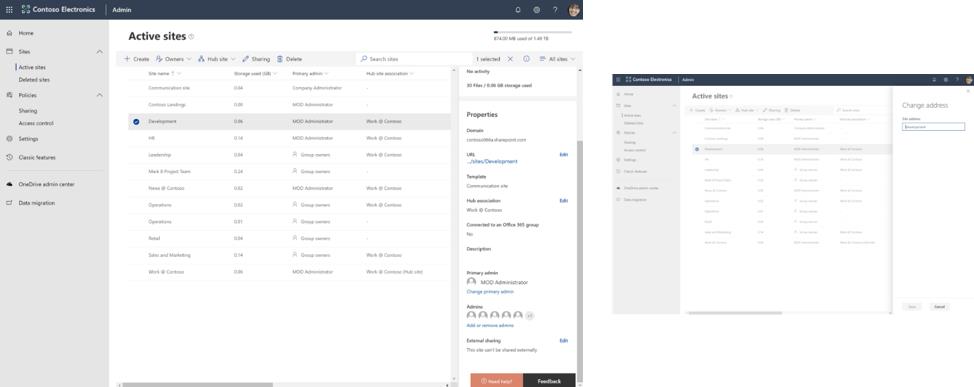

If you are worried if you are going to have broken links, stop worrying! The changes to the site URL will have no impact since access requests to the old URL will be redirected to the new URL, meaning that users will not need to update their links and bookmarks.
SharePoint Site Swap (Coming Soon)
A new Windows PowerShell cmdlet (Invoke-SPOSiteSwap) will be available soon that allows admins to replace the root site within a tenant, e.g. https://contoso.sharepoint.com with an existing site, such as https://contoso.sharepoint.com/sites/<modernsite>. This is extremely useful if you have a classic site as the root site of the tenant and you want to replace it with a modern site.
To learn more about all the announcements for administrators, click here.
What’s New for Security and Compliance
If it is nothing but impressive to see the way SharePoint and Office 365 introduces new collaboration features, it is not less impressive the investments made on security in the Office 365 platform. In 2017, Microsoft has launched a licensing model that includes an impressive security feature set called Microsoft 365. This is a bundle that includes:
- Windows 10
- Office 365
- Enterprise Mobility + Security
This bundle comes in three different flavors:
If you want to know more about all the security features included Microsoft 365, click here.
Below, are the main announcements for Security and Compliance.
Sensitivity Labels for SharePoint Sites (Private Preview)
Collaborating in a secure and protecting the information in your tenant is critical, specially if you have sensitive information.
By using Sensitivity Labels, you can apply security and access policies to SharePoint sites based on the sensitivity of the site. You can create sensitivity labels (ex: Confidential Document) and associate them with policies in the Microsoft 365 Security and Compliance Center to for example restrict users from download or print documents or even share them with external users. These labels can then be applied to files, emails, groups, sites and teams to enforce consistent policies across the information in your tenant.
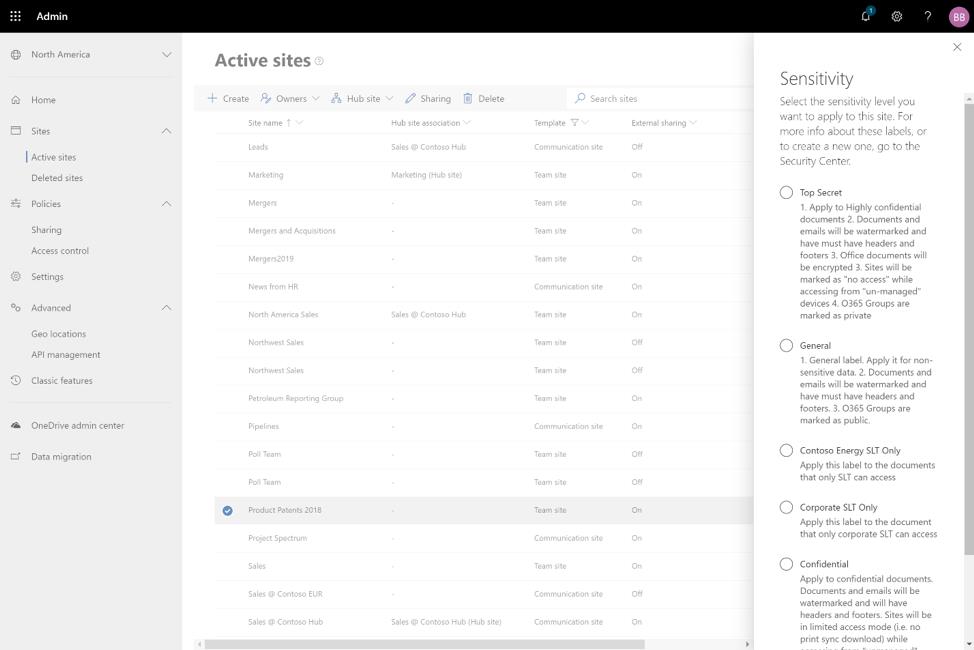

One of the major security announcements of the event is that soon it will be possible to edit protected documents with Sensitivity Labels as long as you have edit permissions on the document. This is a major update since before this update, it was not possible to edit protected documents at all.
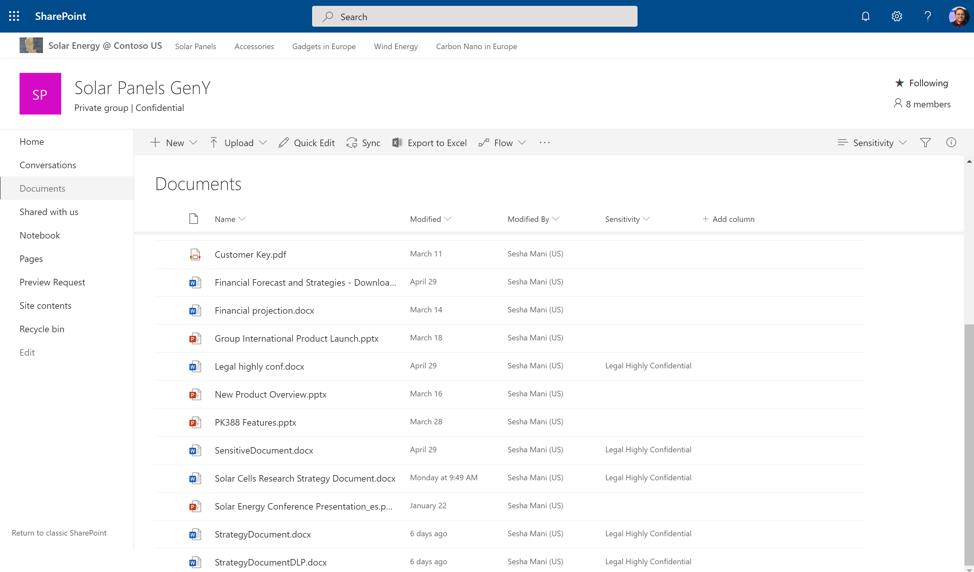

External Access Expiration (Preview Q3 CY19)
Another important update announced in the event is that it will be possible for a tenant administrator to specify how long external users can have access to sites and the content that is shared with them. Once the expiration date is reached, the external user will no longer have access to the site or content unless their access is extended by the site owner or a new sharing invitation is sent.


DLP Restricted Sharing (Private Preview Q3 CY19)
With this new update, it will be possible for organizations to block sharing as anonymous anonymous links of content flagged as sensitive by DLP (Data Loss Prevention).


OneDrive Restricted User Access (Private Preview)
It will be possible to prevent external users to create OneDrive sites and to access other users’s OneDrive sites.
To learn more about all the announcements for security and compliance, click here.
What’s New for SharePoint Server
There are two major announcements for SharePoint Server. support for SQL Managed Instances and support for Azure Stack.
SQL Managed Instances
It will now be possible to run SharePoint Server 2019 on SQL Managed Instances, allowing SharePoint to take advantage of the benefits of managed instances with SharePoint environments hosted in Azure. To learn more about SQL Managed Instances, click here.
Azure Stack
It will now be possible to install SharePoint on Azure Stack (Azure running On-Premises). To learn more about Azure Stack, click here.
To learn more about the announcements for SharePoint Server, click here.
Fluid Framework
Fluid Framework was first announced at Build and there isn’t yet a lot of information available. According to Microsoft, Fluid Framework is:
“A developer technology for building a new class of shared, interactive experiences on the web. It offers three key capabilities. First, experiences powered by the Fluid Framework will support multi-person coauthoring on web and document content at a speed and scale not yet achieved in the industry. Second, it provides a componentized document model that allows authors to deconstruct content into collaborative building blocks, use them across applications, and combine them in a new, more flexible kind of document. Third, the Fluid Framework makes room for intelligent agents to work alongside humans to translate text, fetch content, suggest edits, perform compliance checks, and more.”
One thing is for sure: it is a huge announcement and a possible game changer for multi-user collaboration scenarios with a lot of room for AI.
An impressive example shown at Build is a browser showing 9 browsers, each one with a text being translated to their own language!


Later this year, we will start to see new experiences taking advantage of Fluid Framework in Office applications and a SDK will also be made available for developers!
Other Relevant Announcements
Some other relevant announcements:
- New Capabilities for Microsoft Stream
- New Capabilities for Yammer
- Create Lists from Excel Files
- SharePoint File Storage Improvements
New Capabilities for Microsoft Stream
Now it is possible to securely record, upload and share videos using Microsoft Stream mobile app.


Additionally, it is possible to insert polls or surveys directly into videos with Microsoft Forms.


To learn more about Microsoft Stream announcements, click here.
New Capabilities for Yammer
Yammer will have a new feature that allows you to ask a question and then you or a group administrator can mark the best answer. It will be also possible to add intelligent, bot-like responses to frequently asked questions.


To learn more about Yammer announcements, click here.
Create SharePoint Lists from Excel Files
Several innovations were announced on the SharePoint side and specifically in SharePoint Lists but my favorite one is the possibility to create a SharePoint List from Excel. Users just have to choose the Excel file, the desired table and then confirm the columns and their data types in SharePoint. Easy and powerful!


SharePoint File Storage Improvements
This is not an announcement by itself but some interesting numbers on improvements that were made in the SharePoint File Storage over the last few years:
- Accessing data from Microsoft 365 is ten times faster than it was just two years ago
- User’s experience in Office 365 is three times faster than a year ago, with investments across architecture that accelerate your experience even when you are working far from your own data center
- Users can view more than 320 file types, without requiring dedicated applications, across Microsoft 365 web, mobile, and desktop applications and Windows 10
- Differential sync, coming to OneDrive, will synchronize large files significantly faster and considerably reduce network utilization by the sync process
Summary
If you want to know more about what recent updates in the SharePoint and Office 365 world, I invite you to read all about the latest announcements from the SharePoint Conference:
- SharePoint Conference 2019 web site (with video to the event keynote)
- Microsoft 365 innovations for the intelligent workplace post by Jeff Teper
- SharePoint home sites: a landing for your organization on the intelligent intranet
- New Yammer investments add engagement and compliance capabilities
- New Microsoft Stream mobile features, interactivity and more announced at SharePoint Conference 2019
- OneDrive announcements—SharePoint Conference 2019
- Turbocharging Microsoft 365 cloud user experiences
- Getting started with Microsoft Search
- Updates to SharePoint security, administration, and migration
- New Records Management solution and machine learning updates come to Microsoft 365 compliance
- What’s new for SharePoint Server
- Announcements for SharePoint developers
- Microsoft adoption resources center
- Optimizing business solutions with SharePoint and Office 365 at SPC19
To finish, I leave you the fantastic contribution from Luise Freese that summarizes the major announcements of the event!


To read the first part of this post series, click here.
Related Articles
If you want to convert your tenant’s root classic site into a modern SharePoint site, click here.
To learn why your business should migrate to SharePoint Online and Office 365, click here and here.
If you are a SharePoint administrator or a SharePoint developer who wants to learn more about how to install a SharePoint 2019 farm in an automated way using PowerShell, I invite you to click here and here.
If you learn how to greatly speed up your SharePoint farm update process to ensure your SharePoint farm keeps updated and you stay one step closer to start your move to the cloud, click here.
If you prefer to use the traditional method to update your farm and want to learn all the steps and precautions necessary to successfully keep your SharePoint farm updated, click here.
If you want to learn how to upgrade a SharePoint 2013 farm to SharePoint 2019, click here and here.
If SharePoint 2019 is still not an option, you can learn more about how to install a SharePoint 2016 farm in an automated way using PowerShell, click here and here.
If you want to learn how to upgrade a SharePoint 2010 farm to SharePoint 2016, click here and here.
If you are new to SharePoint and Office 365 and want to learn all about it, take a look at these learning resources.
If you are work in a large organization who is using Office 365 or thinking to move to Office 365 and is considering between a single or multiple Office 365 tenants, I invite you to read this article.
If you want to know all about the latest SharePoint and Office 365 announcements from Ignite and some more recent announcements, including Microsoft Search, What’s New to Build a Modern Intranet with SharePoint in Office 365, Deeper Integration between Microsoft Teams and SharePoint and the latest news on SharePoint development, click here.
If your organization is still not ready to go all in to SharePoint Online and Office 365, a hybrid scenario may be the best choice. SharePoint 2019 RTM was recently announced and if you to learn all about SharePoint 2019 and all its features, click here.
Happy SharePointing!


![[FIX] BizTalk Server 2010, 2013, 2013 R2 & 2016 errors “Class not registered (WinMgmt)” or “Access denied”](https://blogit.create.pt/wp-content/uploads/2018/07/access-black-and-white-blur-270514-218x150.jpg)












